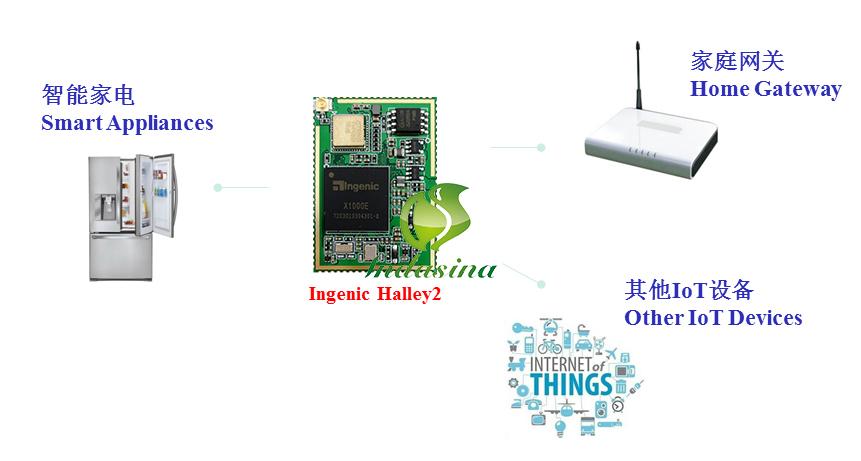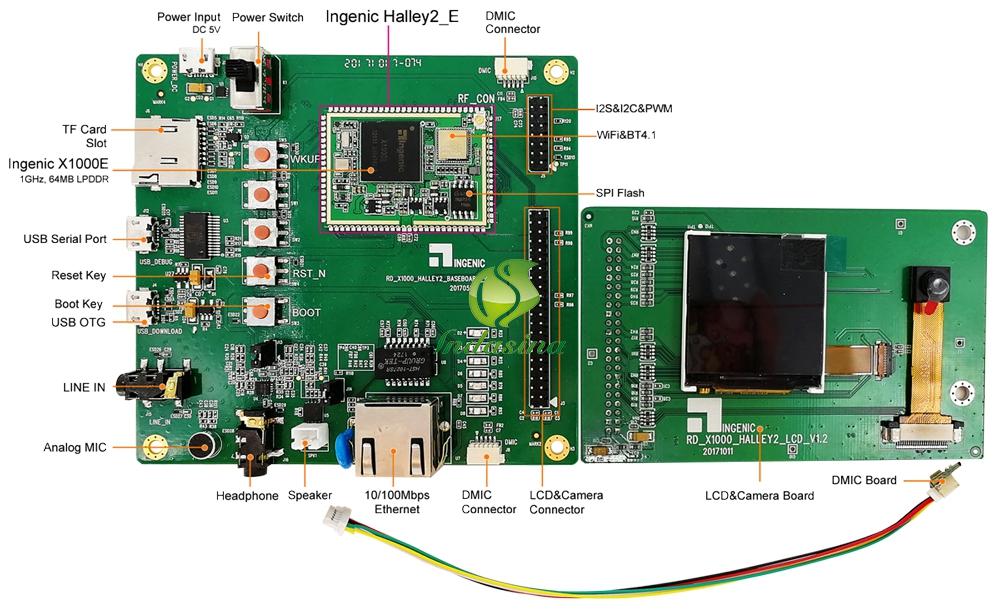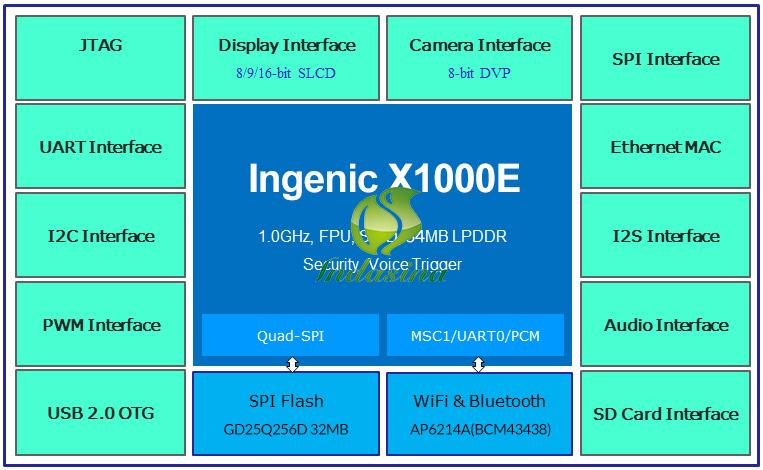Products Overview:
• High performance:
- Running up to 1GHz, supporting hardware FPU and SIMD instructions.
- Being qualified for algorithms such as speech recognition, image recognition, denoising, echo cancellation, APE/FLAC decoding etc.
• Ultra-low power consumption:
- Standby: 2mW.
- Average: 200mW.
- Maximum: 700mW.
• Rich peripherals:
- Supports WiFi, bluetooth, ethernet, LCD, digital and analog MIC, camera, SD card, USB 2.0 OTG, UART, I2C, SPI, PWM, GPIO etc.
• Open source Linux SDK:
- Running Linux 3.10 kernel, supports WiFi and bluetooth protocols.
• Plated half-hole module:
- Can be used in target products, reducing time to market.
Target applications:

Halley2 Development Kit:

Halley2 Block Diagram:

Halley2 Detailed Specifications:
|
PHYSICAL
|
|
Form factor
|
94-pin plated half-hole module.
|
|
Dimensions
|
26 x 37 x 3 mm.
|
|
ON-BOARD COMPONENTS
|
|
Processor
|
Ingenic X1000E SoC, up to 1.0 GHz.
- Embedded 64MB LPDDR.
- Embedded high quality audio CODEC.
|
|
Memory
|
16MB SPI NOR flash.(Compatible with SPI NAND flash)
|
|
Wi-Fi
|
AP6214A(BCM43438) single-band 2.4GHz IEEE 802.11b/g/n.
|
|
Bluetooth
|
AP6214A(BCM43438) Bluetooth 4.1 (Bluetooth Low Energy), Bluetooth 3.0, Bluetooth 2.1 + EDR.
|
|
POWER
|
DC/DC(1.25V,1.8V,3.3V),LDO(2.5V)
|
|
Clocks
|
24MHz, 32.768kHz; 26MHz (Wi-Fi/BT).
|
|
EXTERNAL INTERFACES (Note: signals of some ports are being multiplexed.)
|
|
Display
|
8/9/16-bit, SLCD.
|
|
Digital MIC
|
x 4.
|
|
Analog MIC
|
x 1.
|
|
Line-In
|
x 1.
|
|
Camera
|
8-bit, DVP.
|
|
SD Card
|
x 1.
|
|
USB OTG
|
Host & Client Modes .
|
|
I2S
|
Master & Slave Modes.
|
|
I2C
|
x 3.
|
|
UART
|
x 2.
|
|
SPI
|
x 2.
|
|
PWM
|
x 5.
|
|
Ethernet MAC
|
10/100 Mbps, RMII Interface.
|
|
JTAG
|
Standard EJTAG interface.
|
|
POWER
|
|
Input
|
5V DC.
|
|
Power consumption
|
Standby (no radio): 2mW.
Average: 200mW, Maximum (with radio): 700mW
|
|
SOFTWARE
|
|
Supported OS
|
Linux 3.10.
|
|
Code availability
|
Open source.
|
Prepare the Hardware
a) Power Supply
You may use either J1 or J4 to provide power to the Halley2 development kit.
1) POWER_DC 5V Input (J1). Power switch (K1) is used to enable/disable the power.
2) USB_DOWNLOAD Port (J4). Except power supply, this port can also be used to program the Flash.
b) Debug Port: USB_DEBUG (J12)
J12 is the USB to serial debug port.
Boot Halley2 Normally
First use two USB cables to connect the USB DOWNLOAD (J4) and USB DEBUG (J12) ports with your PC.
Then press the RESET key (SW4) to boot the Halley2.
Configure the parameters of the USB serial port to 57600bps-8N1.
Boot Halley2 to the USB BOOT MODE (Flashing the Halley2)
Press and release the RESET key (SW4) while keeping pressing download the BOOT key (SW3), then Halley2 will boot to the USB BOOT MODE.
You may use the USB cloner tool to flash the SPI flash under the USB BOOT MODE.